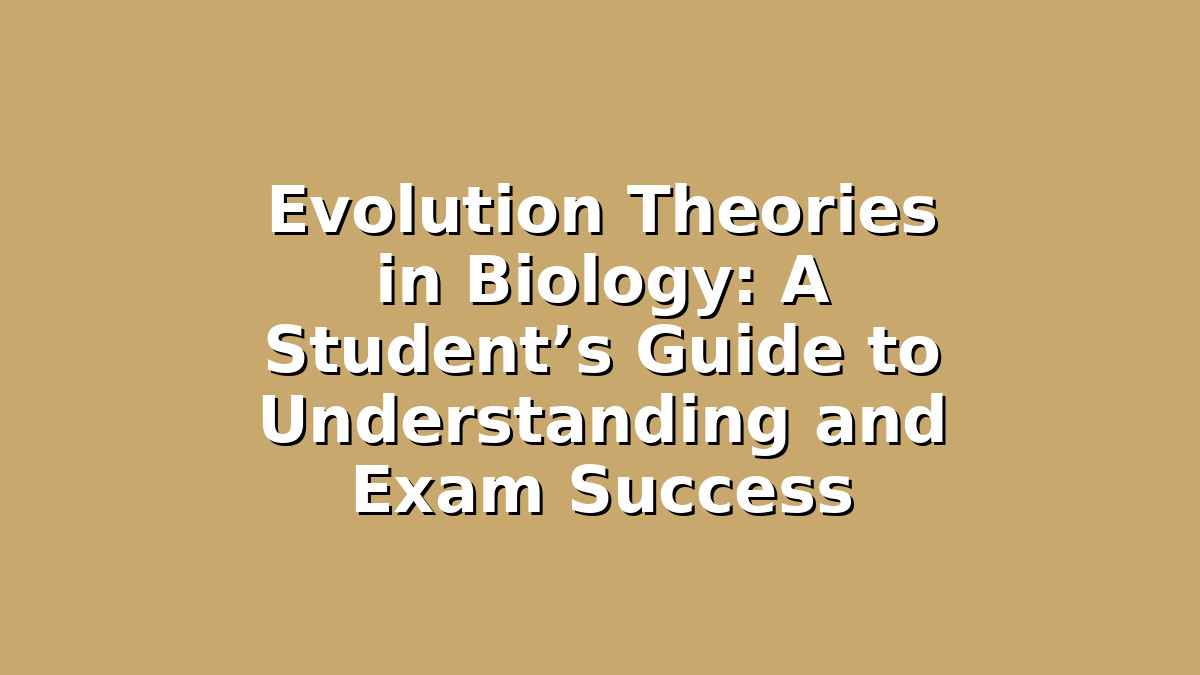Introduction
Evolution is one of the most fundamental concepts in biology and serves as a cornerstone for understanding the diversity of life on Earth. For students preparing for exams, grasping evolution theories can sometimes feel overwhelming due to the complexity and historical depth involved. However, with the right approach and study strategies, mastering this topic becomes much more manageable and even enjoyable. This article will walk you through the main evolution theories, explain their significance, and provide practical study tips to help you excel in your biology exams.
Section 1: Understanding the Key Evolution Theories
To build a strong foundation, it’s essential first to understand the primary theories that explain how evolution occurs. Here are the three most important ones:
1. Darwin’s Theory of Natural Selection
Proposed by Charles Darwin in the 19th century, this theory suggests that individuals with traits better suited to their environment are more likely to survive and reproduce. Over time, these advantageous traits become more common in the population. Key concepts include variation, competition, adaptation, and survival of the fittest.
2. Lamarckism (Inheritance of Acquired Characteristics)
Before Darwin, Jean-Baptiste Lamarck proposed that organisms could pass on traits acquired during their lifetime to their offspring. For example, a giraffe stretching its neck to reach higher leaves would have offspring with longer necks. Although this theory is largely outdated, it’s important historically and for understanding the progress of evolutionary biology.
3. Modern Synthesis (Neo-Darwinism)
This combines Darwin’s natural selection with Mendelian genetics. It explains evolution through changes in gene frequency within populations, integrating mutation, genetic drift, gene flow, and natural selection. This theory provides a comprehensive framework that is widely accepted today.
Study Tip: Create comparison charts or flashcards that outline the main points, advantages, and limitations of each theory. Visual aids can help you quickly recall differences during exams.
Section 2: How to Effectively Learn Evolution Concepts
Evolution involves many interconnected ideas, and learning them requires both memorization and conceptual understanding. Here are some study techniques tailored to evolution:
1. Use Diagrams and Flowcharts
Evolutionary processes can be complex to visualize. Diagrams of natural selection cycles, cladograms (evolutionary trees), and genetic variation help clarify concepts. Try drawing these yourself rather than just looking at them—active learning boosts retention.
2. Relate Theories to Real-Life Examples
Connecting evolution theories to real organisms or scenarios makes the material relatable. For instance, think about antibiotic resistance in bacteria as a modern example of natural selection. Understanding practical examples solidifies your grasp and makes answering application questions easier.
3. Practice Past Exam Questions
Look for previous exam papers or practice questions about evolution from your curriculum. This not only tests your knowledge but helps you get familiar with how questions are framed. Try explaining your answers aloud or writing them under timed conditions.
Study Tip: Form study groups or discussion pairs. Teaching concepts to peers is one of the best ways to reinforce your own understanding and clear doubts.
Section 3: Tackling Common Challenges and Exam Strategies
Many students find evolution tricky because it mixes biology with historical context and abstract concepts. Here’s how to overcome these challenges:
1. Clarify Terminology
Terms like “fitness,” “adaptation,” “gene flow,” and “genetic drift” appear frequently. Make a glossary of terms with simple definitions and examples. Revisit this glossary regularly and use the words in sentences or short explanations.
2. Understand the Timeline of Evolutionary Thought
Knowing when and why different theories emerged helps in essay-type questions or when asked to compare ideas. For example, recognize that Lamarckism preceded Darwin’s natural selection, and the Modern Synthesis came later to incorporate genetics.
3. Answer Structuring Tips
When writing exam answers on evolution:
– Start by defining key terms.
– Explain the theory clearly and concisely.
– Use relevant examples.
– If comparing theories, highlight differences or improvements.
– Conclude with a summary or implication related to biodiversity or adaptation.
Study Tip: Practice writing short paragraphs on each theory and get feedback from teachers or peers to improve clarity.
Conclusion
Mastering evolution theories is a vital step in your biology journey and exam preparation. By understanding the main theories, using effective study techniques, and approaching exams with clear strategies, you can confidently tackle this topic. Remember, evolution is not just about memorizing facts—it’s about appreciating the dynamic story of life’s diversity. Stay curious, practice regularly, and don’t hesitate to ask for help when needed. Your hard work will pay off, and you’ll find evolution becoming one of the most fascinating areas of biology.
Good luck with your studies!

Responses